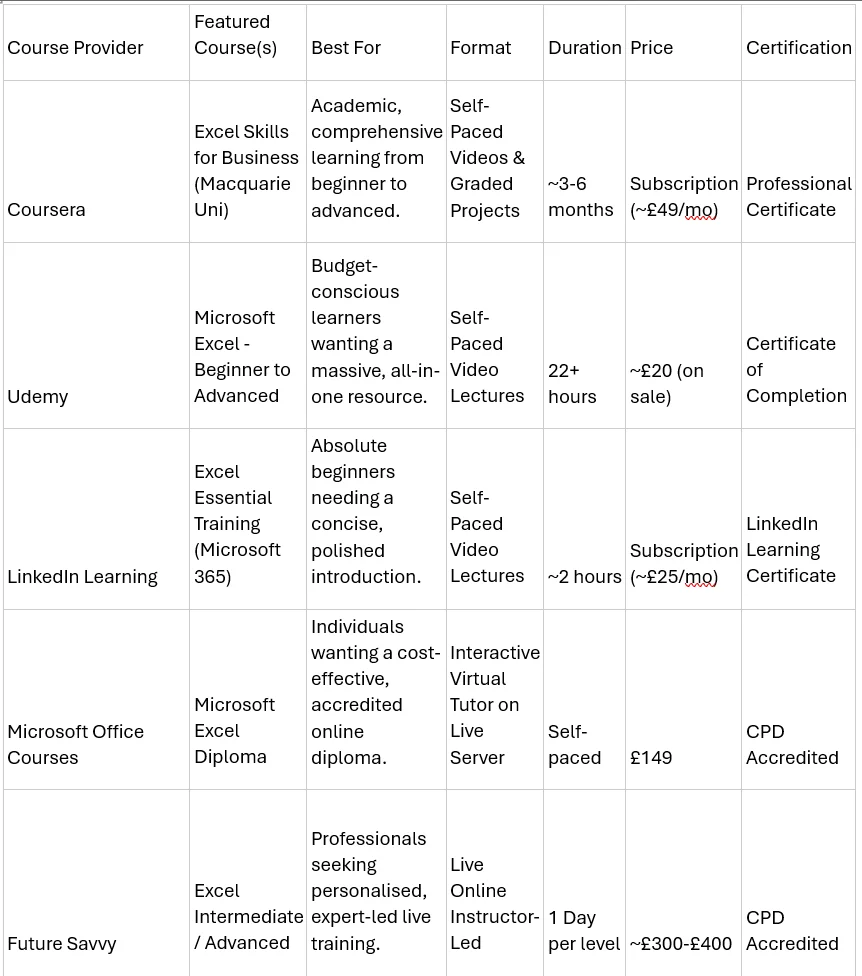- TIPS & TRICKS/
- The 5 Best Online Excel Training Courses/


The 5 Best Online Excel Training Courses
- TIPS & TRICKS/
- The 5 Best Online Excel Training Courses/
The 5 Best Online Excel Training Courses
Microsoft Excel is an absolute necessity in modern business. From small companies to global corporations, Excel is the go-to tool for everything from budgeting and data analysis to scheduling and reporting. In fact, office workers spend on average 38% of their work time using Excel, yet more than half have never had formal Excel training.
In this article, we will go over the 5 Best Online Excel Training Courses, as well as how to research and select the options that will best suit you and your team’s needs.
What Is Microsoft Excel? More Than Just a Spreadsheet
While often perceived as a simple tool for creating lists and budgets, Excel’s true power lies in its capacity to transform raw data into actionable business intelligence. It can be best understood through four key pillars:
Data Organisation & Management
Excel provides a robust framework for structuring vast amounts of information. By organising data into formal tables, users can easily sort, filter, and retrieve critical records, ensuring data integrity and an efficient workflow.
Calculation & Automation
This is where Excel's reputation was built (link to Excel formulas article). Its library of built-in functions allows for everything from simple arithmetic, like $SUM and $AVERAGE, to complex financial and statistical calculations.
Data Analysis & Insights
Excel is a formidable analysis tool. Features like PivotTables allow users to dynamically summarise, group, and analyse large datasets to uncover trends, patterns, and insights that would otherwise remain hidden.
Visualisation & Reporting
Communicating data-driven insights is critical, and Excel provides a comprehensive suite of tools to do so. Users can create a wide variety of compelling charts, graphs, and even interactive dashboards to present complex data in a clear, digestible format for reports and presentations.
If you want to learn more, make sure to check our step-by-step guides on different data visualisation techniques in Excel.
How to Learn Excel Quickly and Effectively in 4 Quick Steps
Although most users are self-taught, this often leads to a plateau where users rely on a small set of familiar but inefficient tools. The following roadmap outlines the key stages of taking your understanding of Excel to the next level.
Step 1: Build Foundational Muscle Memory
The fastest way to improve is to understand the core mechanics of navigating the application. For instance, boost spreadsheet speed by ditching the mouse and mastering key shortcuts. Use Ctrl + Arrow keys to zip around data, Ctrl + C/V/Z for core actions, and Ctrl + ; to stamp today’s date. Lastly, lock headers with Freeze Panes so column titles stay visible while you scroll.
Step 2: Master the Core Formulas and Functions
Before looking for an online Excel training course, learn Excel’s “big five” functions first. These are: SUM, AVERAGE, COUNT for quick totals and stats, IF for decision-based logic, VLOOKUP for table lookups (then graduate to XLOOKUP), and CONCATENATE/& for merging text. Knowing these takes care of most professional tasks before you ever need the niche functions.
Step 3: Embrace Data Analysis & Visualisation
PivotTables convert huge, flat datasets into interactive summaries you can slice, dice, and re-angle in seconds. Pair those insights with clear, well-labelled charts to turn raw numbers into instantly graspable stories for colleagues and stakeholders.
Step 4: The Case for Structured Learning
Do you even need to bother and for the best online Excel training courses then?
It is important to acknowledge that a significant gap often exists between a user's perceived and actual skill level. For example. Up to 57% of UK office workers rate themselves as "intermediate”. However, research indicates that only 5-10% of users worldwide have ever created a PivotTable, a quintessential intermediate skill.
Moreover, expert Excel users are 400% more likely to have received formal training than their non-expert colleagues. Expert-led instruction, practical exercises with feedback, and a formal certification are what really validates your skills to current and future employers.
Choosing the Right Excel Training Program: Courses, Certificates, and Degrees
Before choosing the best online Excel training course, it's crucial to establish a framework for making your choice. The best program is not a one-size-fits-all solution; it's the one that aligns with your current skill level, career goals, learning style, and budget.
Define Your Goal and Starting Point
Begin by performing an honest self-assessment of your abilities and needs. Training providers typically structure their offerings into three tiers:
- Beginner - you are new to Excel or have very limited experience.
- Intermediate - you are comfortable with the basics but want to work more efficiently.
- Advanced - you are already a proficient user but want to unlock Excel's full potential.
Understand the Learning Formats
Here you can pick from several formats:
- Self-Paced Video Courses
- Live Online Instructor-Led Classes
- Interactive Virtual Tutors
We will explain this in detail in the next section about the 5 best online excel training courses.
The Value of Certification
In a competitive job market, a formal certification serves as a powerful, verifiable credential on your CV. Make sure to look for courses that offer CPD (Continuing Professional Development) accreditation, a recognised standard in the UK that signals high-quality, structured learning. Research has shown that holding certified Excel skills can increase a professional's likelihood of promotion and boost earnings by an average of 12%
The 5 Best Microsoft Excel Online Training Courses
Coursera
Offered by Macquarie University, this four-course specialisation is the top choice for learners seeking a structured and academic-style curriculum. The entire specialisation takes approximately three to six months to complete, assuming a commitment of about 10 hours per week, and is available through a monthly Coursera subscription. The program consists of self-paced video lectures, readings, and covers everything from essential to advanced functions.
Udemy
Udemy's flagship Excel course represents outstanding value for money. For a low, one-time fee, you gain lifetime access to a vast and comprehensive library of video content, covering the entire spectrum of Excel skills. However, the sheer volume of content (over 22 hours of video) means that learning is highly dependent on your own discipline and motivation.
LinkedIn Learning
For anyone who feels intimidated by Excel or has zero prior experience, this course on LinkedIn Learning is the perfect entry point. The curriculum is tightly focused on the absolute essentials needed to get started. More importantly, with a total duration of just over two hours, it makes it a low-commitment way to test the waters of Excel training.
Microsoft Office Courses
This London-based Microsoft Certified Academy offers a unique and highly cost-effective route to a CPD-accredited Excel Diploma. You work on a live version of Excel hosted on a server, guided by a "virtual tutor." This system provides instructions, monitors your actions, and provides immediate, interactive feedback on the exercises. Essentially, the course bundles Beginner, Intermediate, and Advanced courses into a single, self-paced program.
Future Savvy
Finally, Future Savvy is an excellent choice for professionals who value direct, real-time access to an expert instructor. The courses are delivered as intensive one-day sessions, making them a time-efficient way to upskill. Their primary advantage is the live, instructor-led format. Unlike pre-recorded videos, this approach allows learners to ask specific questions, get immediate answers, and have the pace of the class adjusted to their needs.

Excel is a powerful tool for business if you know how to unlock its full potential. In this article, we have gone over the 5 best online Excel training courses, as well as how to go about choosing the one that is right for you and your team.
At Future Savvy, we offer personalised instructor-led training courses suitable for both beginners and advanced users. Contact us today to find out more.
Frequently Asked Questions (FAQ)
This is likely "context truncation." The chat history is part of the context window, and as the conversation gets longer, earlier messages are pushed out to make room for new prompts and retrieved data. Start a new chat to reset the window with a fresh focus.
Use the in-app Copilot (e.g., in Word) with the document open. In M365 Chat, be explicit with your grounding: "Using only the document /path/to/Policy_v4.docx, answer the following..." This scopes the retrieval and prevents Copilot from searching your wider tenant.
The "context window" is the session's "working memory," which resets after the chat ends. Microsoft is also rolling out a "Memory" feature that allows Copilot to learn your preferences (e.g., writing style, common collaborators) persistently. This persistent memory helps shape future prompts but is separate from the token limit of a single conversation.
Microsoft does not publish a specific token number for M365 Copilot, as this changes with the underlying models. Instead, it provides practical guidance (as of Oct 2025): Copilot can retrieve from documents up to ~1.5 million words for summarisation, can rewrite ~3,000-word passages, and can ground a single M365 Chat prompt against ~20 relevant files.
Related Articles
 Tips & Tricks
Tips & Tricks25 Most Popular Excel Formulas & Functions
Mastering Excel formulas and functions boosts efficiency, accuracy, and workflow, so the article offers a downloadable PDF of 25 essential formulas - ranging from SUM and IF to VLOOKUP and XLOOKUP - each with syntax and practical use cases. The article also spotlights five must-know Excel visualizations (heat maps, box plots, Pareto charts, histograms, and scatter plots) and compares Excel’s hands-on data control with Power BI’s cloud-hosted, interactive dashboards for large datasets.
 L&D Insights
L&D InsightsLiteracy vs Digital Literacy: What Are the Differences?
Traditional reading-and-writing literacy has broadened into digital literacy—the ability to locate, evaluate, create, and communicate information safely and effectively through technology. The article traces this evolution from basic “computer literacy” of the 1990s to today’s multifaceted concept that spans information, media, and AI literacy. Digital skills now underpin social inclusion, workforce readiness, and democratic participation, while gaps in access, competence, and support exacerbate inequality.
 Tips & Tricks
Tips & TricksHow to Use Excel Lookup with Multiple Criteria
This blog explains how Excel’s LOOKUP functions—particularly XLOOKUP and VLOOKUP—can retrieve data based on multiple criteria. It walks through a step-by-step example of finding an employee’s sales in a specific region, showing both an XLOOKUP formula and a VLOOKUP alternative that uses a helper column.
